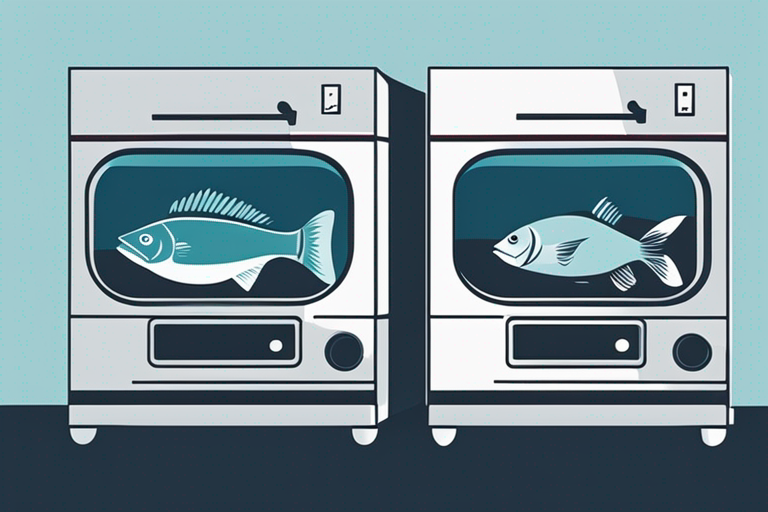
Can You Refreeze Previously Frozen Fish?
Get Your Free Food Safety Cheat Sheet
30 most common foods with instant answers. Print it and stick it on your fridge—completely free!
Can You Refreeze Previously Frozen Fish?
When it comes to handling and storing fish, there are specific guidelines to follow to ensure food safety. One common question that arises is whether it's safe to refreeze fish that has already been frozen. In this blog post, we will delve into this topic and provide you with all the essential information you need to know about refreezing previously frozen fish.
Understanding the Basics of Freezing Fish
Freezing is a popular method of preserving fish to extend its shelf life. When fish is frozen, the low temperatures slow down the growth of bacteria and other microorganisms that can cause food spoilage. However, it's crucial to freeze fish properly to maintain its quality and safety.
Proper Freezing Techniques for Fish
When freezing fish, follow these guidelines to ensure optimal quality and safety:
- Clean the fish thoroughly before freezing.
- Remove any scales, guts, and bones.
- Wrap the fish tightly in plastic wrap or aluminum foil to prevent freezer burn.
- Label the packaging with the date of freezing to track its shelf life.
- Store the fish in the coldest part of the freezer to maintain its freshness.
Can You Refreeze Previously Frozen Fish?
The general rule of thumb is that it is safe to refreeze fish that has been previously frozen, but there are some important considerations to keep in mind.
Factors to Consider Before Refreezing Fish
Before deciding to refreeze previously frozen fish, consider the following factors:
- Thawing Method: If the fish was thawed in the refrigerator, it can be refrozen. However, if it was thawed at room temperature, it is not safe to refreeze.
- Storage Conditions: Check the quality of the fish before refreezing. If the fish has been stored properly and shows no signs of spoilage, it can be refrozen.
- Time and Temperature: Ensure that the fish has not been left out at room temperature for an extended period. Bacteria can multiply rapidly at room temperature, leading to foodborne illnesses.
Safety Precautions When Refreezing Fish
To refreeze previously frozen fish safely, follow these precautions:
- Thaw the fish in the refrigerator to maintain its quality.
- Check for any signs of spoilage, such as off smells or slimy texture, before refreezing.
- Refreeze the fish promptly after thawing to minimize bacterial growth.
- Avoid refreezing fish multiple times, as it can affect its texture and flavor.
Tips for Properly Storing Fish
Proper storage is essential to maintain the quality and safety of fish, whether fresh or frozen. Follow these tips to ensure optimal storage conditions:
- Refrigerator Storage: Store fresh fish in the refrigerator at temperatures below 40°F (4°C).
- Freezer Storage: When freezing fish, set the freezer temperature to 0°F (-18°C) or lower for long-term storage.
- Packaging: Use airtight containers or freezer bags to prevent freezer burn and maintain freshness.
- Labeling: Label the packaging with the type of fish and the date of freezing to track its shelf life.
Conclusion
In conclusion, it is generally safe to refreeze previously frozen fish if done correctly and under the right conditions. By following proper thawing methods, storage guidelines, and safety precautions, you can enjoy frozen fish while ensuring its quality and safety. Remember to always prioritize food safety when handling and storing fish to prevent foodborne illnesses and enjoy delicious meals with peace of mind.

Authoritative Food Safety References
These agencies and university labs inform every tip and health precaution we publish.
USDA FoodKeeper – Cold Storage Guidelines
Official refrigerator, freezer, and pantry timelines maintained by the U.S. Department of Agriculture.
Visit USDA FoodKeeperFDA Produce Safety Rule & Grower Guidance
Field-to-fridge handling practices that prevent contamination of fruits, vegetables, and leafy greens.
Visit FDA Produce SafetyCDC Foodborne Illness Prevention Hub
Surveillance-backed guidance on pathogens, symptoms, and steps to reduce foodborne illness risk.
Visit CDC Food SafetyUC Davis Postharvest Technology Center
University research detailing optimal storage atmospheres for produce after harvest.
Visit UC Davis PostharvestPenn State Extension – Home Food Preservation & Safety
Peer-reviewed extension bulletins on safe canning, chilling, and reheating practices.
Visit Penn State ExtensionHow should I safely thaw frozen fish?
How long can previously frozen fish be stored in the refrigerator?
Can I cook previously frozen fish without thawing it first?
How can I tell if previously frozen fish has gone bad?
Get Your Free Food Safety Cheat Sheet
30 most common foods with instant answers. Print it and stick it on your fridge—completely free! Want more? Upgrade to the complete guide with 70+ foods.
Scan your food directly and get instant safety info using our AI-powered camera feature.